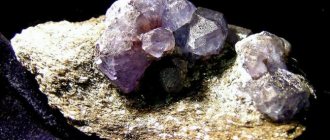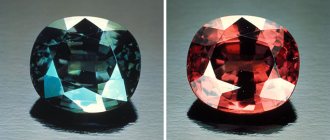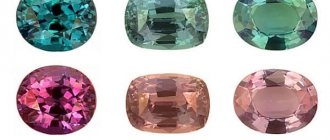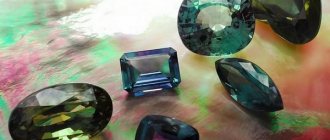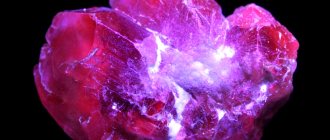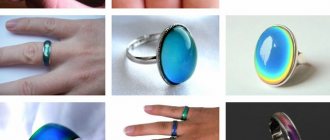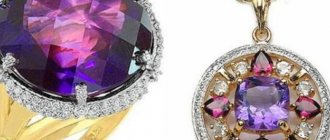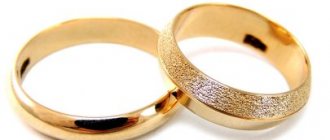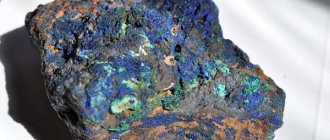Alexandrite is still a very young gemstone, because it was discovered only in the nineteenth century.
Natural stone is a rare mineral and is therefore highly valued all over the world, resulting in a cost of tens of thousands of dollars. A special feature of this stone is its ability to change its color depending on the lighting - pleochroism - from emerald green to bright red. The purer the color produced, the more expensive the alexandrite.
Ural stone is widely used in the production of jewelry that amazes with its beauty and grace. It also finds application in science - quantum mechanics, medicine, cosmetology (synthetic analogues).
History of the Ural gem
Alexandrite was discovered in the Urals in 1934 on the sixteenth birthday of Emperor Alexander II by Finnish geologist N. Nordenschild. Since this was the year the Tsar came of age, the stone was named after him and was presented to the birthday boy by jewelry craftsman Perovsky.
But the first mention of the Peacock Eye nugget was found in the four-thousand-year-old Indian treatise “Mahabharata”.
The mineral was especially popular among noble society in the nineteenth century and was worth fabulous money.
In Russia, since 1980, they began to grow and create artificial synthetic minerals - fakes of natural stone, the cost of which was several times cheaper.
Currently, the bulk of production comes from large fields located in Brazil, Tanzania, Sri Lanka, Africa and Russia (Malyshevskoye field). Ural alexandrites are the most valuable minerals, as they have a bright color and a contrasting transition from one to another.
Is synthetic alexandrite better or worse than the original?
The main advantage of synthetic alexandrite over natural alexandrite is price. Although due to the high cost of production it cannot be called completely cheap, it is still much cheaper than the original. Visually, the stone is indistinguishable: to see the differences, you need a microscope.
Alexandrite synthesized by the Czochralski method has pure and bright colors. It exhibits a strong reversal: it turns from red to green when the lighting changes, and vice versa. Natural stones with such a pronounced color change effect are rare.
Synthetic alexandrite is practical. If you love this amazing stone, you can wear jewelry with it every day without worrying too much about possible loss. Jewelry with natural alexandrites, which cost fabulous amounts of money, will most likely remain in the box most of the time.
Types of Alexandrites
In nature you can find the following types of this mineral:
- Tsimofan, popularly called a cat's eye. It is found very rarely. The light effect of this variety is obtained due to the fact that a large number of small inclusions in the mineral are oriented in the same direction. Therefore, under certain lighting conditions, a bright stripe appears in the middle part of the stone, similar to a cat’s eye.
- Ural Alexandrite is the most valuable stone, the color of which changes from green to red.
- In the deposits of India, a variety is mined that changes color from yellow to pink.
How to distinguish synthetic alexandrite from natural one
The differences between synthetic and natural alexandrite are noticeable under a microscope. Gemologists focus on the number and nature of inclusions. The easiest to recognize are stones synthesized by the Czochralski method - they are very pure. In addition, synthetic alexandrites exhibit stronger reversal and fluoresce red in ultraviolet.
Cat's eye stones produce a faint fluorescence - orange-red on the inside, and pale yellow on the surface. They are also distinguished using a microscope. Synthetic alexandrites are dominated by fine silty particles, while natural ones are dominated by tubular and needle-shaped inclusions.
Chemical composition of the Ural gem
The mineral contains mainly chromium (giving green), titanium and iron (red elements). It is the properties of chromium ions and the crystal lattice that cause the stone to change color. Vanadium, which can also influence the transformation of alexandrite, is rarely found among inclusions.
Ural natural stone has the formula BeAI2O4, which is due to the chemical composition of complex beryllium and aluminum tetroxide, and is a type of the mineral chrysoberyl.
Another feature of this mineral is its hardness, which is higher than that of emerald. It is eight and a half units according to the Moss scale.
The density of alexandrite is determined by the plug 3.5-3.8 g/cm3, and the refraction is 1.74-1.76.
Questions/answers ❓
How to distinguish a fake?
Counterfeits are different. Alexandrite can be grown artificially. There are methods that are slow, energy-intensive and expensive. And this synthetic gem will cost a lot. Such imitations are difficult to distinguish it from a natural gem.
Typical fakes are spinels and corundums created by human hands.
Important
: Alexandrites are not the only ones that change color from green to red. Some polychroid sapphires can change color in this way, as well as garnets with an admixture of chromium. As you understand, the prices of garnets and alexandrites are “two big differences.”
From Egypt, our gullible compatriots bring “real Egyptian alexandrites.” But there are no deposits of chrysoberyls and alexandrites in this country.
How to care?
Alexandrite does not crumble or fade. It's difficult to scratch. The gem can be cleaned with ultrasound and steam (if there are no cracks in the stone filled with gel or oil).
Who should wear it?
Preferably diplomats and lawyers.
How to wear?
There is a strong belief among people that wearing a single piece of jewelry with alexandrite is dangerous.
What is the price?
The cost of a crystal is determined by:
- cutting;
- color;
- transparency;
- size.
The first three indicators are ideal - the stone is a delight!
What colors are there?
“Emerald by day, ruby by night” was when electric lighting did not exist. At night they looked at the stone by candlelight. But the light of a candle and our electric lamps have different color spectrums.
Try to examine your alexandrite in the dark by candlelight - as our great-grandmothers saw it.
Russian regulatory documents establish the following shades of alexandrite:
- green;
- bluish green;
- moderate bluish-green;
- very bluish green;
- faint yellowish green;
- moderate yellowish green.
Where can I buy?
If you want natural alexandrite, it is very difficult to find it in jewelry stores.
Trying to find it on large trading platforms, such as eBay, is possible, but doubtful.
In principle, it is not very wise to buy a stone of this class on the Internet. This is not a piece of jasper. If possible, it is better to go to the mining site. Alexandrites and emeralds are still being mined in the Urals. The best fly abroad. What’s left is sold on the “black market”, and it has its own rules and laws...
There are even websites of companies where they quite officially sell seemingly completely natural gems. The company's gemologist will confirm the naturalness of the stone (I would try not to).
When is the best time to buy?
Give jewelry with alexandrite as a gift to those born in August. And it’s better to buy them on Friday, the 9th day of the lunar month.
Buy alexandrite with a “cat’s eye” effect on Wednesday, Thursday or Friday. And wear the jewelry for the first time in the evening.
Who was born:
- January 30;
- February 20th;
- March 4 and 13;
- April 2 and 13;
- May 2;
- July 18;
- August 9 and 24;
- September 9 and 25;
- November 26;
- December 25
This is your birthstone.
What stones does it go with?
With aventurine, morion, malachite, carnelian.
Widow's stone?
There are several versions here:
- During the First World War, wives of officers (many of them were hereditary aristocrats) had jewelry with alexandrite. Husbands remained forever on the fields of the First World War. And the widows continued to wear sad memories - jewelry with gems.
- The same story repeated itself during World War II.
- “There is information that when paying for Lend-Lease, the USSR sold synthetics to the United States (like natural ones). When they sorted it out, they couldn’t come up with anything better than making rings and earrings and giving them to their pilots as gifts for girlfriends and wives. Pilots often died in war, and the name “widow’s” was assigned to alexandrite.”
Medicinal properties
Traditional healers say that it is worth paying attention to the healing properties of alexandrite:
- stops bleeding;
- it is used to clean the blood;
- used in the treatment of blood vessels and heart;
- has a positive effect on the functioning of the spleen and liver;
- helps with diseases of the pancreas;
- treats alcoholism;
- copes with neurological disorders.
Traditional medicine advises wearing jewelry made using this stone for healing, for example, a ring with Ural alexandrite.
Magic endows this mineral with the ability to enhance the qualities inherent in a particular person: it subjugates the weak under its power and can destroy, and supports the strong and helps to overcome problems.
It is also believed that this gem has different properties depending on the time of day: in the evening it enhances feelings of jealousy and passion, during the day - confidence and calmness.
And since the assassination of the Russian emperor, a tradition arose in Rus' of widows wearing this stone as evidence of the loss of a loved one.
In India, the nugget is considered a symbol of peace and is worn by priests.
Place of Birth ?
Tanzania
Zambia
India
Madagascar
Sri Lanka
They have:
- Tanzania;
- Zambia;
- India;
- Madagascar;
- Sri Lanka.
It is believed that the Russian deposit (indigenous, by the way) has already been depleted. There is no (official) mining there.
But how can a hereditary miner from a neighboring village pass by an abandoned mine or an interesting rock outcrop? They don't even pass by. Therefore, those living nearby (and not only nearby) spend their free time like their great-grandfathers - with a shovel and hammer in their hands. They look for (and find) precious crystals. But these stones end up on the black market.
Stone price
A natural gem has a very high cost, which depends on its color, jewelry processing, and the presence of defects. As a rule, it is rarely used independently in products; it is complemented by pearls, rubies, emeralds and diamonds. Alexandrite is in the top five in terms of price, along with such expensive minerals as sapphire, diamond, ruby and emerald.
The frame for gemstone products is most often made of gold, but silver is also used for these purposes.
Alexandrite can be purchased at a price of five hundred dollars (artificial), and natural Ural - from five thousand. The maximum value is twenty thousand dollars per carat.
The factors that determine the price are the following:
- color saturation of the mineral regardless of the time of day;
- presence of inclusions and cloudiness.
Mid-level buyers can purchase synthetic stones that look completely indistinguishable from the original. In Russia, they produce an analogue of alexandrite, which has a lilac color similar to amethyst.
Jewelry with alexandrite
The traditional setting for alexandrite is gold. The gem can be one or combined in a product with diamonds, emeralds, garnet, and amethyst. It is believed that in addition to aesthetic appeal, this also increases the positive energy of the stone.
Most often, alexandrite is placed in a ring or ring - a tribute to belief in the magical properties of the mineral - but earrings and pendants with alexandrite are no less beautiful and popular. There are also exclusive products: tiaras, bracelets, necklaces, which use natural alexandrites of various cuts. Most often, such jewelry is made to order and has a fabulous price.
How to recognize an analogue
A distinctive feature of nuggets is the change in color with changes in illumination, which is caused by the presence of three optical axes in the nugget. Interestingly, under fluorescent lamps this effect is practically invisible.
The only mineral that is similar in appearance to Ural alexandrite is green andalusite. But it is just as rare as the original.
More often, as a replacement for gems, synthetically grown analogs are used - spinel and corundum, which are similar to the original in chemical composition. They can be distinguished by their color - unlike a nugget, they shimmer from blue-gray to pink and are much more intense.
The main candidates for replacing alexandrite are artificial chrysoberyl, phenacite, cubic zirconia, inamori, garnet, andalusite, and spinel. When buying jewelry, you need to check whether there is a gemological examination certificate.
Despite all the instructions, it is quite difficult, if not impossible, for an ordinary person to distinguish the original from the analogue on their own. The best option would be to contact a jewelry specialist - using special instruments (spectroscope and refractometer) he will determine the origin of the mineral.
What to look for when choosing jewelry with alexandrite
A good solution would be to purchase jewelry that includes an alexandrite stone. But choosing it from a photo is not an easy task, since under different lighting conditions the mineral can look different. It is better to check for yourself how the color of the stone changes when light falls on it from different angles. The most expensive and rare specimens have especially rich colors, but sometimes it is more important that you simply like the gem, and that the play of colors evokes only positive emotions.
The following are also important in determining the quality of a stone:
- place of origin - the most valuable are alexandrites mined in the Urals;
- cleanliness, transparency, absence of cracks and inclusions that could affect the durability of the stone;
- good polishing, no contamination;
- cut and proportions that give the stone maximum brightness.
LiveInternetLiveInternet
Quote from Marina_Ushakova's message
Read in full In your quotation book or community!
Alexandrite. The most mysterious gem of the Ural Mountains
It was first found in the 30s of the 19th century at the famous Emerald Mines. Initially it was supposed to be called diophonite (di - two, fanos - shiny), that is, highly shiny, changing color. But since the significant day of the heir to the throne’s coming of age was approaching, the gem received the name alexandrite. This stone became fatal for the Tsar-Liberator. Alexandrite is believed to have predetermined the fate of the emperor. For a long time, at the Russian court there was a tradition of wearing jewelry with alexandrite in memory of the deceased emperor. Alexandrite has a rather interesting “mythical side”; esotericists believe that it is a stone of “love and loneliness,” and according to Indian legends, the stone symbolizes “loyalty and devotion.” This stone can also be called quite expensive; the best examples of alexandrite are valued at between $20,000 and $35,000 per carat.
According to the writer Peskov, alexandrite has green mornings and bloody evenings. Thanks to a small admixture of chromium, the stone has an amazing property: in daylight it has a green or bluish-green color, in artificial evening light it becomes crimson or reddish-violet or pink-violet. In addition, there is a shade of red-purple, orange-yellow, emerald green, bronze and very rarely colorless. The mineral is very hard.
Alexandrite is a type of chrysoberyl. Its chemical composition is unique. In addition to iron and titanium, this stone contains chromium, the ions of which cause an impressive change in color, called color reversal by gemologists. In some cases, the process of color change is also influenced by the vanadium contained in the mineral. Alexandrite is transparent, but very rarely colorless. Its most common color is bluish-green. Less common is olive with shades of yellow and brown. Stones mined from different deposits may differ significantly in color palette. Ural alexandrite, which is rightly considered the standard of beauty, has a bluish-green color in daylight, and crimson or purple-red in artificial light. Gems from Africa or Brazil are colored brownish-greenish during the day, and under artificial lighting they can become several tones redder than Ural stone. Alexandrite from the island of Sri Lanka under the bright rays of the sun resembles the color of Ural minerals, and in the evening light it turns purple. In terms of depth of color reverse, Ural alexandrites are the leaders.
The Ural emerald mines are considered to be the primary deposit of alexandrite. Currently, their reserves are practically depleted, and stone mining is not being carried out.
A deposit of fairly large crystals was discovered in the 80s of the last century in Brazil, but this mine was completely mined within three months, after which finds of the precious stone became sporadic. Today, Sri Lanka is considered the largest supplier of alexandrite to the world market. The mineral is also mined in Thailand, India, Tanzania and Madagascar. Experts admit that none of the stones mined at these deposits can compare with the absolute beauty of the Ural gem. The collection of the Ural Geological Museum of Mining University (Ekaterinburg) contains the second largest aggregate in Russia (about 100 crystals) of this gem. In the old days these crystals were called pawns.
The price of alexandrites depends on their color, depth of color reverse (Alexandrite effect), degree of purity and weight. Among the most expensive are Ural gems that have a greenish tint. A flawless mineral mined in the Ural deposits can be more expensive than diamonds. The best examples of alexandrite are valued at between $20,000 and $35,000 per carat. It is important to know that natural alexandrite is a very small stone, and therefore the faceted insert rarely exceeds the weight of one carat. However, if such a stone does occur, its cost, according to gemstone catalogs, can reach $1,000,000. The cost of low-quality alexandrites, which have a weak alexandrite effect and grayish-brownish tones, usually does not exceed several hundred dollars per carat. This is comparable to the cost of lab-grown artificial alexandrite, which ranges from $200 to $500 per carat.
Thanks to its ability to change color, alexandrite has gained fame throughout the world as a magical stone. There are entire legends about this gem. Sorcerers claim that during the day the stone becomes an emerald, and at night it turns into a ruby. There is also a belief among gemstone seekers that in places where alexandrite is found, it is useless to look for emeralds. Alexandrite has such strong energy that it can help in the fight against any adversity in life. However, the highlight is that the owner of this stone must match it in fortitude. Otherwise, alexandrite will have a destructive effect on its owner. Astrologers believe that this mineral is able to predict the future, especially if it carries some kind of negativity. Anticipating danger, the stone begins to behave unusually - during the daytime it can change its color to “evening”, that is, become red or brown. The appearance of yellowish tints in the color of alexandrite is considered a particularly alarming signal. In this situation, it is necessary to prepare for difficult life trials. But the emerald color of the mineral predicts a comfortable and comfortable existence. Alexandrite is often used as a magical amulet. However, it is truly useful only for people who are impulsive and highly emotional. He can make them reasonable and calm. Alexandrite teaches prudence and calmness even in the most difficult situations, therefore it is recommended for people of such professions as diplomat, clergyman, judge, lawyer, military man, sailor, rescuer. Alexandrite often brings good luck and helps you get rich. Therefore, he is held in high esteem by gambling people. It is also suitable for bright women who are accustomed to making an impact in society. The stone is often considered a symbol of jealousy and amorousness, again due to its ability to change color from a calm green to an exciting red. In India, it is believed that alexandrite is able to change its color in accordance with the mood of its owner. Alexandrite has been found to help meditate. The mineral pumps higher energy through the chakras and helps establish balance between the physical, mental and astral bodies. Alexandrite is also known to help unleash creative potential. It brings good luck to people of creative professions, researchers, travelers and scientists.
Alexandrite was nicknamed widow's in the countries of the former USSR. At the beginning of the twentieth century, the production of artificial alexandrites began in the Soviet Union, and in the thirties this gemstone reached the peak of its popularity. Almost every woman wanted to have jewelry with synthetic alexandrite. Men bought them as gifts for their lovers. During the Great Patriotic War, many owners of the precious stone were widowed. Human rumor linked the fact of their widowhood and loneliness with the magical properties of alexandrite. The reputation of a beautiful gem was undeservedly tarnished. For many years, the notoriety of a stone that brings loneliness was attached to it. However, the splendor and mystery of alexandrite continued to excite secular beauties. In order to prevent the evil prophecy from coming true, it was customary to wear this stone in pairs in earrings and sets, or to combine it with other varieties of beryl. Nowadays, exquisite jewelry with alexandrite has regained its well-deserved recognition.
https://lutch.ru/dragocennye-kamni/aleksandrit#i-7
https://lutch.ru/dragocennye-kamni/aleksandrit#i-2
https://avrorra.com/aleksandrit-kamen-foto-svojstva-i-znacheniya/
Properties and uses of stone
The main niche for using alexandrite is jewelry. Large specimens go into private collections. Due to its rarity and cost, the stone is rarely used for medicinal and magical purposes.
Physical properties
The chemical formula of alexandrite Al2BeO4 indicates that the composition includes aluminum and beryllium oxide. Properties of the stone:
- changes color under infrared or fluorescent lighting;
- hardness on the Mohs scale – 8.5 units out of 10;
- density – 3.6–3.8 g/cm³;
- resistant to acids (with the exception of hydrofluoric and boric);
- unstable to alkalis;
- melting point – 1800 °C;
- does not magnetize.
View this post on Instagram
Publication from Silver and natural stones (@_silver_stories_) January 15, 2021 at 7:36 PST
Medicinal properties
It is believed that the gem helps with:
- varicose veins;
- diabetes mellitus;
- osteochondrosis;
- weak blood vessels;
- alcoholism;
- liver and gallbladder diseases;
- insomnia;
- depression;
- neurosis.
The magical properties of alexandrite
The stone is actively used by magicians, astrologers, and worn as amulets and talismans. He is credited with the ability to:
- give inner harmony;
- help in the fight against life's difficulties;
- develop creative abilities;
- improve mood;
- bring good luck in financial matters and transactions;
- warn of impending changes and troubles by changing the color of the glow to yellow;
- improve performance.
Alexandrite can enhance both positive and negative emotions of the owner. Therefore, it is not recommended for long-term wear.
It is believed that alexandrite can lead to separation from a loved one, so it should be worn in pairs, for example, a ring and earrings or a bracelet and a pendant. It is combined with sapphire, garnet, topaz, and citrine.
A little about the unusual properties of the stone in the following video:
Which zodiac sign is alexandrite suitable for?
Not all zodiac signs can wear the stone - choleric natures will receive a negative impact in the form of increased temperament and manifestations of incontinence. Not recommended for wearing by Virgos, Cancers, Aries. Positive effects of the mineral:
- It will help Geminis find harmony, peace of mind, solutions in life situations;
- It will give Scorpio the strength to fight with himself, to increase the level of development, especially spiritual;
- Leos will be given success and career advancement;
- will reveal the talents of Aquarius, develop intuition;
- Libra will be given a variety of thinking and a creative approach to business;
- It will help Pisces develop logic and increase reaction speed, especially in case of danger;
- will calm the emotions of Taurus, soften outbursts of anger and irritability;
- It will help Sagittarius achieve their goals, become more self-confident, and realize their ideas.
Also watch the video interview about the stone:
